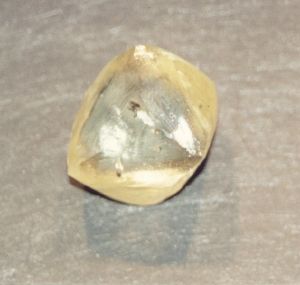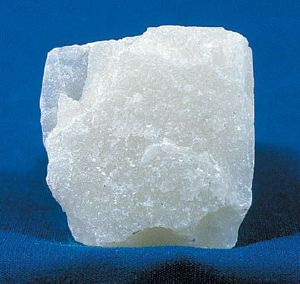Difference between revisions of "Mohs scale of mineral hardness" - New World Encyclopedia
(added image) |
Rosie Tanabe (talk | contribs) |
||
| (11 intermediate revisions by 5 users not shown) | |||
| Line 1: | Line 1: | ||
| − | {{ | + | {{Copyedited}}{{Images OK}}{{Submitted}}{{Approved}}{{Paid}} |
| − | [[Image:DiamanteEZ.jpg|thumb|Diamond, the hardest | + | [[Image:DiamanteEZ.jpg|thumb|Diamond, the hardest mineral in nature, is given a hardness rating of 10 on the '''Mohs scale of mineral hardness''']] |
| − | |||
| − | The '''Mohs scale of mineral hardness''' characterizes the scratch resistance of various [[mineral]]s through the ability of a harder material to scratch a softer material. | + | The '''Mohs scale of mineral hardness''' characterizes the scratch resistance of various [[mineral]]s through the ability of a harder material to scratch a softer material. It was created in 1812 by the German [[Mineralogy|mineralogist]] [[Friedrich Mohs]] and is one of several definitions of [[Hardness (materials science)|hardness]] in [[materials science]]. By determining the hardness of a mineral, we can make decisions about the ways in which it can be used. |
| + | {{toc}} | ||
| + | [[Image:Talc block.jpg|thumb|Talc, a very soft mineral, is given a hardness rating of 1 on the Mohs scale]] | ||
| + | == A scale of ten minerals == | ||
| − | Mohs based the scale on ten minerals that are | + | Mohs based the scale on ten minerals that are readily available. As the hardest known naturally occurring substance, [[diamond]] is at the top of the scale and is given the rating of 10. At the other end of the scale is [[talc]], a very soft mineral, which is given a rating of 1. |
| − | The Mohs scale is a | + | The Mohs scale is not a linear scale. For example, [[corundum]] (9) is twice as hard as [[topaz]] (8), but diamond (10) is almost four times as hard as corundum. The table<ref>[http://www.amfed.org/t_mohs.htm Mohs scale of Mineral Hardness] ''American Federation of Mineralogical Societies''. Retrieved May 10, 2007.</ref> below shows the scale and compares it with absolute hardness measured with a [[sclerometer]].<ref>A sclerometer is an instrument used by [[mineralogist]]s to measure the scratch [[hardness]] of materials.</ref> |
{| class="wikitable" | {| class="wikitable" | ||
| Line 21: | Line 23: | ||
|- | |- | ||
|align="center"|2 | |align="center"|2 | ||
| − | |[[Gypsum]] (CaSO<sub>4</sub> | + | |[[Gypsum]] (CaSO<sub>4</sub>•2H<sub>2</sub>O) |
|align="center"|2 | |align="center"|2 | ||
|- | |- | ||
| Line 58: | Line 60: | ||
|} | |} | ||
| − | + | A mnemonic that may be used to remember the above table is: The Geologist Can Find An Ordinary Quartz (that) Tourists Call Diamond.<ref>What is Important About Hardness? ''Amethyst Galleries''.</ref> | |
| − | + | == Measuring hardness on the Mohs scale == | |
| − | + | The hardness of a material is measured against the scale by finding the hardest material that the given material can scratch, and/or the softest material that can scratch the given material. For example, if some material is scratched by apatite but not by fluorite, its hardness on the Mohs scale is 4.5. | |
| − | + | On the Mohs scale, [[fingernail]] has hardness 2.5; copper penny, about 3.5; a knife blade, 5.5; window glass, 6.5; steel [[file (tool)|file]], 6.5. Using these ordinary materials of known hardness can be a simple way to approximate the position of a mineral on the scale. | |
| + | |||
| + | The table below incorporates additional substances that may fall in between two levels. | ||
{| class="wikitable" | {| class="wikitable" | ||
| Line 125: | Line 129: | ||
|[[Aggregated diamond nanorods]] | |[[Aggregated diamond nanorods]] | ||
|} | |} | ||
| + | |||
| + | == See also == | ||
| + | * [[Mineral]] | ||
| + | * [[Diamond]] | ||
| + | * [[Quartz]] | ||
| + | * [[Talc]] | ||
| + | |||
| + | == Notes == | ||
| + | <references/> | ||
| + | |||
| + | == References == | ||
| + | |||
| + | * Dieter, George E. (1989). ''Mechanical Metallurgy, SI Metric Adaptation''. Maidenhead, UK: McGraw-Hill Education. ISBN 0071004068 | ||
| + | |||
| + | * Malzbender, J. (2003). "Comment on hardness definitions." ''Journal of the European Ceramics Society'' 23: 1355. | ||
| + | |||
| + | * Mineral Gallery. 2000. [http://www.galleries.com/minerals/hardness.htm What is Important About Hardness?] Amethyst Galleries. Retrieved May 10, 2007. | ||
| + | |||
| + | == External links == | ||
| + | All links retrieved November 9, 2022. | ||
| + | * [http://www.gordonengland.co.uk/hardness/mohs.htm Mohs Hardness Scale] by Gordon England. | ||
[[Category:Physical sciences]] | [[Category:Physical sciences]] | ||
Latest revision as of 13:04, 10 March 2023
The Mohs scale of mineral hardness characterizes the scratch resistance of various minerals through the ability of a harder material to scratch a softer material. It was created in 1812 by the German mineralogist Friedrich Mohs and is one of several definitions of hardness in materials science. By determining the hardness of a mineral, we can make decisions about the ways in which it can be used.
A scale of ten minerals
Mohs based the scale on ten minerals that are readily available. As the hardest known naturally occurring substance, diamond is at the top of the scale and is given the rating of 10. At the other end of the scale is talc, a very soft mineral, which is given a rating of 1.
The Mohs scale is not a linear scale. For example, corundum (9) is twice as hard as topaz (8), but diamond (10) is almost four times as hard as corundum. The table[1] below shows the scale and compares it with absolute hardness measured with a sclerometer.[2]
| Hardness | Mineral | Absolute Hardness |
|---|---|---|
| 1 | Talc
(Mg3Si4O10(OH)2) |
1 |
| 2 | Gypsum (CaSO4•2H2O) | 2 |
| 3 | Calcite (CaCO3) | 9 |
| 4 | Fluorite (CaF2) | 21 |
| 5 | Apatite
(Ca5(PO4)3(OH-,Cl-,F-)) |
48 |
| 6 | Orthoclase Feldspar (KAlSi3O8) | 72 |
| 7 | Quartz (SiO2) | 100 |
| 8 | Topaz (Al2SiO4(OH-,F-)2) | 200 |
| 9 | Corundum (Al2O3) | 400 |
| 10 | Diamond (C) | 1500 |
A mnemonic that may be used to remember the above table is: The Geologist Can Find An Ordinary Quartz (that) Tourists Call Diamond.[3]
Measuring hardness on the Mohs scale
The hardness of a material is measured against the scale by finding the hardest material that the given material can scratch, and/or the softest material that can scratch the given material. For example, if some material is scratched by apatite but not by fluorite, its hardness on the Mohs scale is 4.5.
On the Mohs scale, fingernail has hardness 2.5; copper penny, about 3.5; a knife blade, 5.5; window glass, 6.5; steel file, 6.5. Using these ordinary materials of known hardness can be a simple way to approximate the position of a mineral on the scale.
The table below incorporates additional substances that may fall in between two levels.
| Hardness | Substance or Mineral |
|---|---|
| 1 | Talc |
| 2 | Gypsum |
| 2.5 to 3 | pure Gold, Silver |
| 3 | Calcite, Copper penny |
| 4 | Fluorite |
| 4 to 4.5 | Platinum |
| 4 to 5 | Iron |
| 5 | Apatite |
| 6 | Orthoclase |
| 6.5 | Iron pyrite |
| 6 to 7 | Glass, Vitreous pure silica |
| 7 | Quartz |
| 7 to 7.5 | Garnet |
| 7 to 8 | Hardened steel |
| 8 | Topaz |
| 9 | Corundum |
| 10 | Diamond |
| >10 | Aggregated diamond nanorods |
See also
Notes
- ↑ Mohs scale of Mineral Hardness American Federation of Mineralogical Societies. Retrieved May 10, 2007.
- ↑ A sclerometer is an instrument used by mineralogists to measure the scratch hardness of materials.
- ↑ What is Important About Hardness? Amethyst Galleries.
ReferencesISBN links support NWE through referral fees
- Dieter, George E. (1989). Mechanical Metallurgy, SI Metric Adaptation. Maidenhead, UK: McGraw-Hill Education. ISBN 0071004068
- Malzbender, J. (2003). "Comment on hardness definitions." Journal of the European Ceramics Society 23: 1355.
- Mineral Gallery. 2000. What is Important About Hardness? Amethyst Galleries. Retrieved May 10, 2007.
External links
All links retrieved November 9, 2022.
- Mohs Hardness Scale by Gordon England.
Credits
New World Encyclopedia writers and editors rewrote and completed the Wikipedia article in accordance with New World Encyclopedia standards. This article abides by terms of the Creative Commons CC-by-sa 3.0 License (CC-by-sa), which may be used and disseminated with proper attribution. Credit is due under the terms of this license that can reference both the New World Encyclopedia contributors and the selfless volunteer contributors of the Wikimedia Foundation. To cite this article click here for a list of acceptable citing formats.The history of earlier contributions by wikipedians is accessible to researchers here:
The history of this article since it was imported to New World Encyclopedia:
Note: Some restrictions may apply to use of individual images which are separately licensed.

